18 May 2024
| Â Intestinal health is one of the most relevant topics in poultry farming in recent years. There are several factors that play a role in intestinal health, with the most important ones being related to microbiota, nutrition, and host response (intestinal integrity and inflammation).. |
- However, evaluating and predicting intestinal health is very complex and often inaccurate.
Nevertheless, intestinal markers are necessary for:
![]() Predicting performance issues
Predicting performance issues
![]() Assessing the effectiveness of intestinal health strategies
Assessing the effectiveness of intestinal health strategies

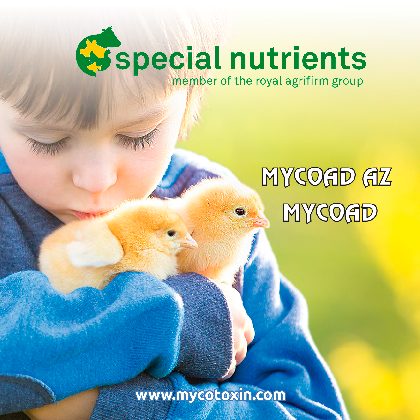
![]() Justifying production interventions
Justifying production interventions
![]() Testing nutritional changes and new diagnostic tools
Testing nutritional changes and new diagnostic tools

In the field, several markers related to intestinal health have been used to help monitor the health status of poultry.
However, the effectiveness of these markers remains debated, mainly due to the difficulty of establishing scientific criteria and the challenges in setting up an ideal and statistically acceptable sample.
Moreover, some of these markers have a low direct correlation with the parameters.

In general, evaluation and classification through macroscopic scoring are conducted after the death or sacrifice of sick animals. However, in poultry farming, performing necropsies to monitor health status is common and extremely important for disease diagnosis and control.
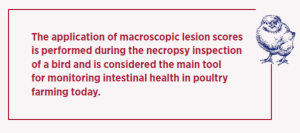
![]()
Figure 1a. Correlation of macroscopic scoring with villus length and T lymphocyte infiltrationÂ
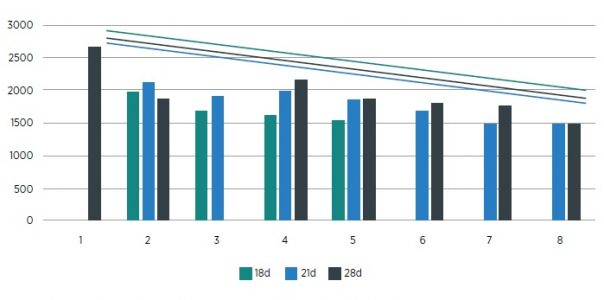
Villus length (μm) in duodenal sections (Y) in relation to macroscopic scoring (X)
Figure 1b. Correlation of macroscopic scoring with T lymphocyte infiltration
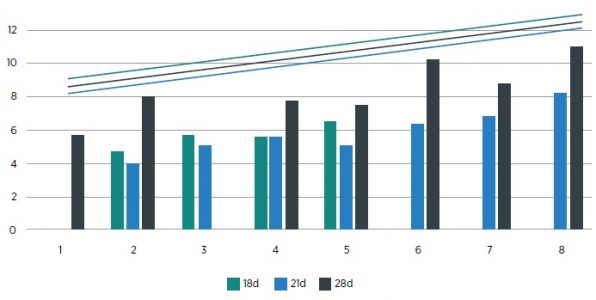
T lymphocyte infiltration (percentage of area) in duodenal and cecal sections (Y) in relation to macroscopic scoring (X)
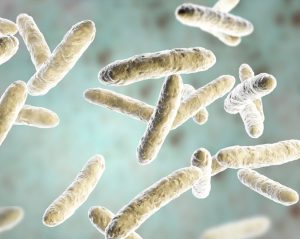
Using the methodology of Teirlynck et al., a nutritional challenge test was conducted by including 20% rye, inducing an increase in the content of NSP (non-starch polysaccharides) in the diets, and subsequently the effects of the probiotic Alterion® (Bacillus subtilis 29784) were evaluated.
Figure 2: Alterion® (Bs 29784) decreases macroscopic scoring in broilers challenged with high levels of non-starch polysaccharides (NSP)
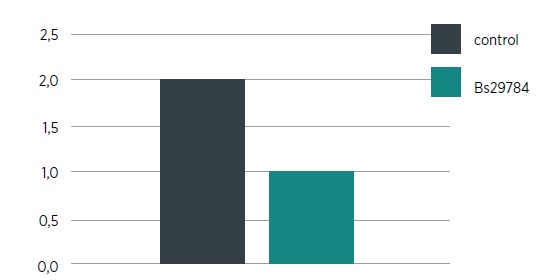
![]() Some methodologies have been developed to facilitate histological evaluation by applying scoring systems for different parameters of the intestinal mucosa, such as:
Some methodologies have been developed to facilitate histological evaluation by applying scoring systems for different parameters of the intestinal mucosa, such as:
- The thickness of the lamina propria
- Epithelial thickness
- Enterocyte proliferation
- Immune cell infiltration
- Goblet cell proliferation
- Presence of oocysts (Kraieski et al., 2017; Belote et al., 2018, 2019).

Indeed, histomorphological evaluations of the intestine can help assess epithelial integrity and inflammation (Gholamiandehkordi et al., 2007).
![]() Furthermore, some studies associate increased villus height, lamina propria thickness, and epithelial cell count with higher body weight in birds (Kraieski et al., 2017).
Furthermore, some studies associate increased villus height, lamina propria thickness, and epithelial cell count with higher body weight in birds (Kraieski et al., 2017).
In studies conducted with the probiotic Alterion®, we observed a significant increase in villus length compared to the control group (without intestinal health additives) in:
- Ileum (control = 0.66 μm; Alterion® = 0.79 μm, P<0.05)
- Cecum (control = 1.25 μm; Alterion® = 1.46 μm, P<0.05).
Table 1 summarizes the results found (Jacquier et al., 2019).
Table 1: Morphology of the ileum and cecum in 42-day-old broilers supplemented with Alterion® (Table adapted from Jacquier et al., 2019).
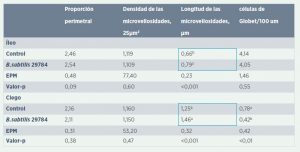
a, b means within a line without a common superscript differ significantly (P <0.05). SEM = Standard Error of the Mean.

- Thus, adding histological evaluations through scoring of different parameters aids in the analysis of epithelial structure. Indeed, using the methodology published by Kraieski et al. (2017), called ISI (I See Inside), we observed that the probiotic Alterion® decreased the ISI score when compared to the negative control group (without additives) and the antibiotic group (10 ppm enramycin) in birds challenged under an experimental model of necrotic enteritis (Figure 3 and 4.)
Specifically, notable is the decrease in the thickness of the lamina propria and mucosal epithelium, as well as the reduction of inflammatory infiltration in these two regions (Figure 3; Tirano et al., 2019).
| These results confirm the potential of the probiotic Alterion® to improve integrity and modulate epithelial inflammation in situations with or without challenge. |
Figure 3: Effects of Alterion® on microscopic ISI scoring in 14-day-old broilers challenged under the necrotic enteritis model
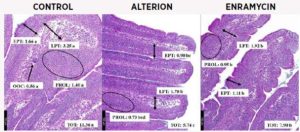
1st image: Control (Challenged without additives); 2nd image: Challenged+Alterion; 3rd image: Challenged+Enramycin. EPT: Epithelial Thickness; LPT: Lamina Propria Thickness; OOC: Oocysts; PROL: Enterocyte Proliferation; TOT: Total Score. Different letters in each parameter indicate statistical differences (p<0.05).
Figure 4: Alterion® decreases ISI score in broilers challenged with necrotic enteritis
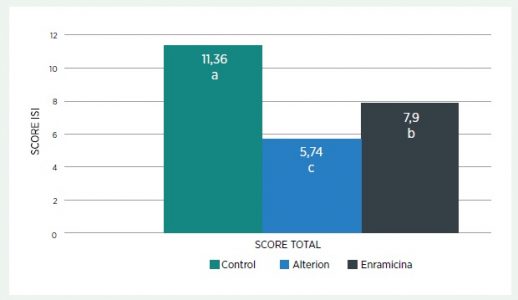
Legend: Control: Challenged; Alterion: Challenged + Alterion®; Enramycin: Challenged + Enramycin. The lower total score observed in the group that consumed Alterion® indicates less inflammation and a more intact intestinal mucosa structure.
Intestinal microbiota
Intestinal microbiota analysis in birds continues to be considered a complex and of limited utility tool in the daily routine of the poultry industry.
- However, this technology has become popular, and several studies have observed significant correlations with intestinal health and zootechnical indices.
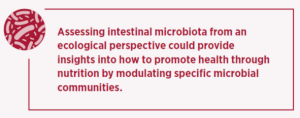
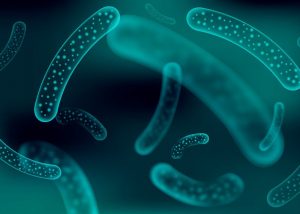
The microbiota can be classified as resistant when the microbial population has higher diversity and a greater number of bacteria with anti-inflammatory properties (butyrate-producing bacteria such as Ruminococcaceae spp and Lachnospiraceae spp) and fewer opportunistic pathogens like Clostridium perfringens and Enterobacteriaceae spp, as well as Salmonella spp and Escherichia coli.
![]() Several studies have demonstrated the benefits of increasing Firmicutes or enhancing the Firmicutes/Bacteroidetes ratios.
Several studies have demonstrated the benefits of increasing Firmicutes or enhancing the Firmicutes/Bacteroidetes ratios.
Among the butyrate-producing Firmicutes, the decrease in the population of Faecalibacterium prausnitzii stands out, which proves to be an important marker in specific pathogenic situations.
- Indeed, Faecalibacterium prausnitzii exhibits anti-inflammatory properties, partly related to the secretion of metabolites that block the activation of the nuclear transcription factor kB (NF-kB) and the secretion of interleukin 8 (IL-8)(Sokol et al., 2008).
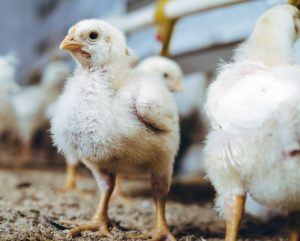
In a necrotic enteritis challenge model, the probiotic Alterion® was observed to increase the alpha diversity of the intestinal microbiota (Chao and Shannon indices) compared to the control group (without additives).
It was also observed a higher prevalence of Ruminococcaceae (P>0.001 – Table 2) with Alterion® supplementation, specifically an increase in Faecalibacterium prausnitzii (+13.4%; P<0.001). As mentioned, this bacterium has been correlated with intestinal health parameters such as villus length and CD3 lymphocyte area.
Furthermore, we observed an increase in the prevalence of bacteria from the genus Ruminococcus and Lachnoclostridium (Table 2), which are responsible for breaking down non-starch polysaccharides into short-chain fatty acids, such as butyrate (an important molecule in epithelial regeneration with anti-inflammatory effects).
Figure 5: Microbiota diversity in cecal content samples of broilers supplemented with Alterion® (adapted from Keerqin et al., 2021)

Control: Control without challenge/additive; NE: Necrotic enteritis challenge; Alterion® + NE: Alterion® + Necrotic Enteritis; Atb + NE: Antibiotic promoter + Necrotic Enteritis.
Table 2: Effects of the probiotic Alterion® on the cecal microbiota (table adapted from Jacquier et al. 2019; Poultry Science 98:2548-54).

Bacteria from the families Lachnospiraceae and Ruminococcaceae are associated with butyrate production, a molecule involved in the modulation of intestinal inflammation and re-epithelialization. The decrease in the genus Bacteroides is related to an increase in the Firmicutes/Bacteroidetes ratio (control group=1.66; Alterion® group=3.17), which has been associated with increased poultry weight gain (Jacquier et al., 2019).
Finally, we cannot forget about microbial metabolites, which can also be related to intestinal health.
- As mentioned earlier, microbiota bacteria convert complex carbohydrates (such as NSPs), fiber, and even proteins into a series of metabolites that have various effects on animal health.
Other metabolites are associated with intestinal integrity, such as hypoxanthine, pantothenate, and nicotinic acid, which are closely related to the control of inflammatory processes and tissue restoration.
- Nicotinic acid (niacin) activates the GPR109A receptor (a type of nicotinic receptor) in the intestinal epithelium, suppressing local inflammation(Singh et al., 2014).
Figure 6: Nicotinic acid modulates inflammation in the intestines of birds(adapted from Singh et al. 2014; Immunity. 16; 40(1): 128-139).
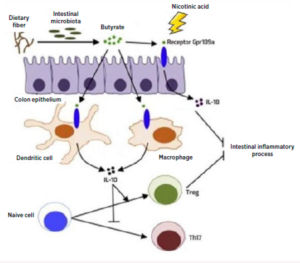
It has been demonstrated that nicotinic acid increases enterocyte proliferation and epithelial “healing” in an in vitro model with CaCo2 cells.
- Furthermore, we observed that supplementation with the probiotic was able to increase nicotinic acid levels in the lumen of the ileum and jejunum of 13-day-old broilers (P<0.01), revealing one of the mechanisms of action of Alterion® in the intestinal health of poultry (Figure 7).
Figure 7: Nicotinic acid content in the ileum and jejunum of broilers supplemented or not with Alterion®
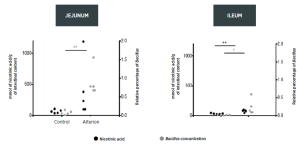
Numerous molecular technologies have been developed to support the understanding of intestinal health, such as metagenomics, metabolomics, metatranscriptomics, etc.; they currently form part of the research focus of numerous research groups and companies in the poultry field.
Nonetheless, due to the complexity of the poultry gut, replicating these methodologies in the field poses a significant challenge for poultry professionals.
| In summary, this article has reviewed some of the important markers of intestinal health in poultry, which can be used both in academic research and practical field applications. Evaluating the effects of a nutritional additive on intestinal health requires the use of various tools and markers, as a single factor does not seem to be sufficient to assess the intestinal health status of a bird.
As we can see, several markers can already guide us in various strategies for monitoring intestinal integrity and even in the evaluation of probiotic products. Revealingly, we have demonstrated that all these markers could be used to evaluate and test the consistency of the Alterion® probiotic as a tool to reinforce intestinal integrity, as well as to modulate inflammation and the microbiota. |

